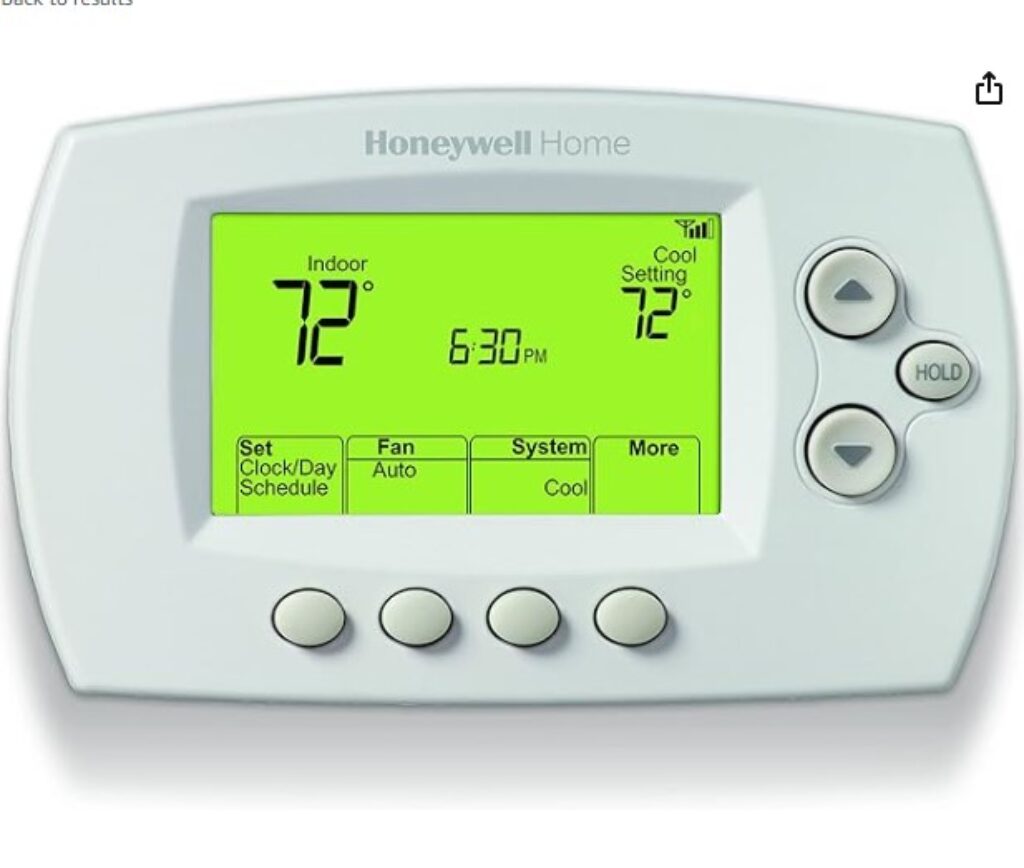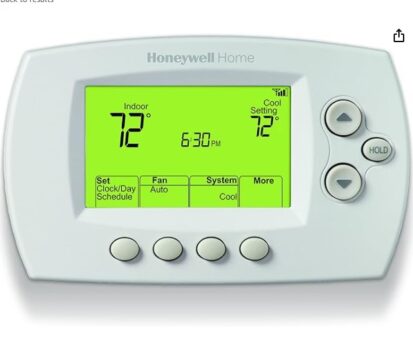As winter’s chill sets in, the art of How to Program Thermostat with your heater becomes not just a skill, but a necessity for maintaining comfort without breaking the bank. Understanding how to effectively program your thermostat can lead to substantial savings on your energy bills while ensuring your home stays warm and welcoming.
In this blog post, we’ll walk through the essential steps of syncing your heating system with your thermostat, tips for optimal temperature settings, and how to make the most out of your device’s features for both warmth and efficiency. Whether you’re a tech-savvy homeowner or new to the world of smart home technology, our straightforward guide will empower you to take control of your indoor climate with confidence.
This step-by-step guide provides instructions How to Program Thermostat with your heater. It is essential to understand how to operate your thermostat to maintain a comfortable and energy-efficient home environment, whether you are a homeowner or a tenant.
Smart thermostats, like the Google Nest Learning Thermostat, adapt to your routine by crafting a heating schedule from your manual inputs over several days. Additional features in some models, such as occupancy sensors or geofencing, adjust the temperature automatically by detecting your presence.
However, the majority of smart thermostats need you to set up a temperature timetable via a mobile app, a modern twist on the traditional manual setup. How to choose the right Heating System Size for my home? How to Choose the Right Thermostat for Baseboard Heaters.
Top-Rated Heating Solutions



Guide: Programming a Honeywell Thermostat
Identify the Thermostat Controls
To locate the thermostat controls on your heater, start by examining the front panel or control panel of the unit. Look for buttons, knobs, or touchscreen options that are specifically labeled for temperature control. For example, you may see buttons marked with “+” or “-” symbols to adjust the temperature up or down, or a digital display with a touch-sensitive screen where you can input your desired temperature. Take a moment to familiarize yourself with these controls, so you can easily make adjustments when needed.



Read the User Manual
Refer to the user manual enclosed with your heater to understand its specific programming and operation instructions. Locate the manual and open it to access the necessary guidance on utilizing the different features and settings available on your thermostat.
Set the Desired Temperature
- Locate the thermostat controls in your home.
- Use the thermostat’s interface to select the desired temperature.
- Adjust the temperature by increments of one degree until you find a comfortable level.
- Set the temperature to suit your personal preferences and ensure a pleasant home environment.
Remember to refer to the specific instructions provided with your thermostat for more detailed guidance.



Program the Daily Schedule
To program the daily schedule on your programmable thermostat, first identify the specific times when you want different temperature settings. Access the thermostat’s programming menu and select the option to set the schedule. Set the desired temperature level for each time period, taking into consideration your comfort needs and energy-saving goals. Lastly, save the schedule and ensure it is activated to automatically regulate the temperature throughout the day. How to Program Thermostat
Utilize Energy-Saving Settings
Enable energy-saving settings on your thermostat to reduce energy consumption and lower utility bills. Explore options like Eco mode or Away mode and turn them on whenever appropriate.
Adjust Fan Settings
Background information: Depending on your heating system, you may have the option to control the fan settings. This can help distribute heat effectively throughout your home. How to Program Thermostat
To adjust the fan settings on your heating system, follow these steps:
- Step 1: Locate the thermostat control panel.
- Step 2: Look for the fan setting option on the control panel. It may be labeled as “Fan” or “Fan Settings.”
- Step 3: Depending on the model of your thermostat, there may be different fan settings available. The most common options are “Auto” and “On”:
Auto: This setting allows the fan to turn on and off automatically along with the heating system. The fan will only run when the heat is actively being generated.On: This setting keeps the fan running continuously, regardless of whether the heating system is actively producing heat or not.
- Step 4: Use the arrow buttons or dial on the thermostat to toggle between the available fan settings.
- Step 5: Once you have selected your desired fan setting, wait for a moment to allow the changes to take effect.
Remember, the specific instructions for adjusting fan settings may vary depending on the make and model of your heating system. If you’re unsure or need further guidance, consult the user manual or contact a professional technician for assistance.
By adjusting the fan settings, you can optimize the distribution of heat throughout your home according to your preferences and maximize energy efficiency. How to Program Thermostat
Consider Zoning Options
Configure your thermostat to accommodate multiple heating zones in your home. Adjust the settings to reflect the personalized temperature control desired in different areas. This will enhance comfort and optimize energy efficiency.
Learn About Remote Access
How to Program ThermostatT? To set up and utilize the remote access feature on your thermostat, follow these steps:
- Check compatibility: Ensure that your thermostat supports remote access functionality by referring to the product specifications or user manual.
- Download the app: Install the manufacturer’s app for your thermostat on your smartphone from the respective app store.
- Create an account: Open the app and create a new account by providing the necessary details. If you already have an account, simply log in.
- Connect your thermostat: Follow the on-screen instructions to connect the app with your thermostat. This usually involves inputting your Wi-Fi network name and password.
- Grant permissions: Allow the app to access your thermostat’s settings and control privileges by granting necessary permissions when prompted.
- Familiarize yourself: Take a moment to explore the app’s user interface and familiarize yourself with the remote access features available. Typically, you can adjust the temperature, set schedules, and monitor energy usage.
Remember, the steps may vary slightly depending on the brand and model of your thermostat. Always refer to the specific instructions provided by the manufacturer for accurate setup and utilization of the remote access feature. How to Program Thermostat
Troubleshooting and Maintenance
If you encounter any issues with your thermostat or heater, refer to the troubleshooting section in the user manual. Ensure regular maintenance of your thermostat and heater by cleaning them and replacing batteries if necessary. Clean the thermostat using a soft cloth and ensure it is free from dust and debris. For battery replacement, locate the battery compartment on the thermostat, remove the old batteries, and insert new ones according to the polarity indicated.
Key Takeaways from the Guide
In conclusion, How to Program Thermostat. mastering the programming and usage of thermostats for your heater is not only feasible but also highly beneficial. Armed with the knowledge provided in this blog post, you can now optimize temperature settings, take advantage of energy-saving features, and enjoy both increased comfort and reduced energy consumption. By implementing these tips, you can make a positive impact on your home, your environment, and your wallet.
Efficient Temperature Control
Mastering the programming of your thermostat is key to achieving efficient temperature control in your home. This process is about striking the perfect balance between comfort and energy conservation. By setting up a heating and cooling schedule that aligns with your daily routine, you can ensure that your home is always at a comfortable temperature when occupied, and energy is not wasted when it’s not.
Modern thermostats offer the convenience of programming through intuitive interfaces or even remotely via smartphone apps. By taking the time to customize your temperature settings, you can reduce your environmental footprint while maintaining a cozy living space and also see significant savings on your energy bills. Whether it’s setting a lower temperature for the hours you’re asleep or adjusting the climate controls ahead of your return home, efficient thermostat programming is a smart move for any household.

- Temperature Considerations: The U.S. Department of Energy recommends setting your thermostat to 68°F while you’re awake and lowering it while you’re asleep or away from home.
- Seasonal Adjustments: Remember to reprogram for warmer months if you’re using a thermostat for cooling as well.
- Smart Thermostat Benefits: If you have a smart thermostat, take advantage of features like geofencing, learning capabilities, and remote adjustments through an app.
Operating Instructions for Heaters. How to Program Thermostat
-
- Familiarize yourself with the type of heater you have: Before using a heater, make sure you understand its specific features, settings, and safety precautions. Read the instruction manual carefully and familiarize yourself with the different parts and functions of the heater
-
- Choose a suitable location: Place the heater on a stable and level surface, away from any flammable materials, such as curtains, furniture, or paper. Ensure that the heater is at least three feet away from any combustible items
-
- Plug it in safely: Check the electrical outlet for any damage or faults before plugging in the heater. Avoid using extension cords and never overload the electrical circuit. Plug the heater directly into a wall outlet that is compatible with its power requirements.
How to Program Thermostat
- Plug it in safely: Check the electrical outlet for any damage or faults before plugging in the heater. Avoid using extension cords and never overload the electrical circuit. Plug the heater directly into a wall outlet that is compatible with its power requirements.
-
- Set the temperature and timer: If your heater provides temperature control, set it to a comfortable level, considering the size of the room and your personal preferences. Some heaters also offer timer functions, allowing you to schedule when the heater turns on or off, ensuring energy efficiency and convenience
-
- Observe safety measures: Always follow the safety guidelines provided by the manufacturer. Never leave a heater unattended, especially when you go to sleep or leave the house. Keep children and pets away from the heater, and never drape anything on top of it. If the heater overheats, emits strange smells or starts malfunctioning, immediately turn it off and contact a professional for assistance
-
- Remember, while heaters provide warmth and comfort during cold weather, they also carry potential risks if not used properly. Safety should always be a priority when using any heating appliance
FAQ: How to Program Thermostat
Q: Why is it important to program my thermostat?
Q: How do I start programming my thermostat? How to Program Thermostat
Q: Can I program my thermostat for different days of the week?
Q: What’s a good temperature to set on my thermostat in winter?
Q: Should I adjust the programming seasonally?
Q: How can I program my thermostat if I have an irregular schedule?
Q: Can I program my thermostat from my phone? How to Program Thermostat
Q: Do all thermostats have programmable features?
Q: How can I tell if my thermostat programming is working correctly?
Q: What should I do if my thermostat programming isn’t saving me money?
How to Program Thermostat
How to Program Thermostat






